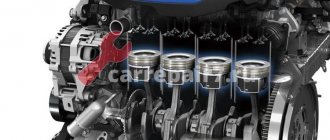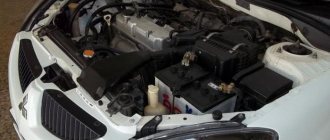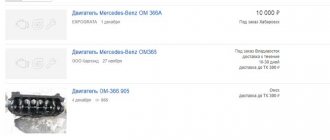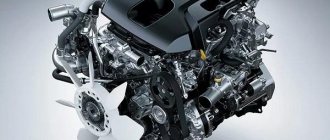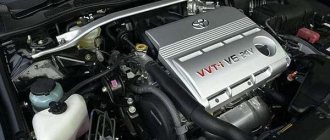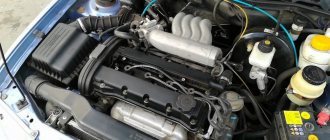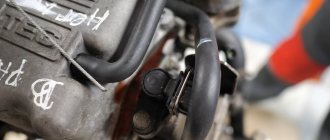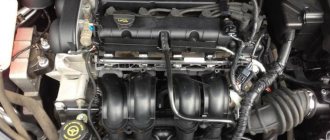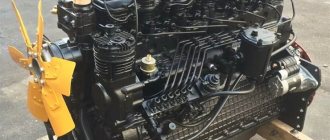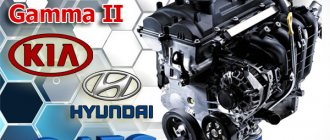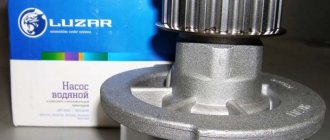The 4GR-FSE engine is the power unit of Toyota cars existing on the market since 2003. Used for prestigious rear wheel drive cars or models with all-wheel drive. The main difference between the engine is Dual VVT-i (adjustment of intake and exhaust phases), as well as systems direct injection fuel.
Engine Toyota 4GR-FSE
4GR engine characteristics
Motor 4GR-FSE
The 4GR engine has the following technical characteristics:
- year of production start – 2003;
- cylinder block from aluminum;
4GR-FSE engine cylinder head - injection power system;
- number of cylinders – 6;
- number of valves per cylinder – 4;
- The piston stroke is 77 millimeters ;
- cylinder diameter – 83 millimeters;
Toyota 4GR-FSE Engine Cylinder Block - has a compression ratio equal to 12;
- the value of the exact engine volume in cubic centimeters - 2499;
- the engine has a power of 207 hp. at 6400 rpm .
- torque - 260 Nm/3800 rpm ;
- fuel used – 95;
- environmental class – Euro 4 , Euro 5 ;
- permissible oil consumption is less than 1000 g. For 1000 kilometers;
- engine oil volume indicator – 6.3. liter ;
- the frequency of lubricant changes ranges from 7,000 to 10,000 kilometers ;
- timing chain drive;
- the approximate engine life is 300,000 kilometers ;
Fuel consumption
Lexus IS250 3rd generation
- The 4GR-FSE engine has the following fuel consumption figures per Lexus IS250 3rd generation With automatic gearbox and rear wheel drive:
- in a mixed cycle - 8.6
- th city - 11.9
- on the road - 6.7
Toyota 4GR-FSE engine under the hood of the Lexus IS 250 - For Lexus GS250 4th generation With 6 automatic transmission And rear wheel drive:
- in a mixed cycle - 8.9
- around town - 12.4
- on the road - 6.9
Lexus GS 250 4th generation
The most important - technical characteristics
When getting acquainted with the motor of the model in question, you cannot ignore the characteristics in any case.
| Years of production | From 2003 to present |
| Manufacturer | plant Kentucky, USA |
| cylinder head | Aluminum |
| Volume, l. | 2,5 |
| Torque, Nm/rev. min. | 260/3800 |
| Power, l. s./about. min. | 215/6400 |
| Environmental standards | EURO-4, EURO-5 |
| Piston stroke, mm. | 77 |
| Compression ratio, bar | 12 |
| Cylinder diameter, mm. | 83 |
| Fuel type | Gasoline, AI-95 |
| Number of valve cylinders per cylinder | 6 (4) |
| Construction scheme | V-shaped |
| Nutrition | Injection, injector |
| Lubrication standard | 0W-30, 5W-30, 5W-40 |
| Possibility of modernization | Yes, potential – 300 l. With. |
| Oil change frequency, km. | 7 000 – 9 000 |
| Fuel consumption liters per 100 km (city/highway/mixed) | 12,5/7/9,1 |
| Engine resource, km. | 800 000 |
| Volume of oil channels, l. | 6,3 |
Technical features of the 4GR-FSE engine
Mechanical features of the power plant - injection system. The compression ratio of such engines is higher than that of similar models.
Engine connecting rod and piston
To create a reverse vortex inside the cylinder, a direct injection port was developed at the head of the block.
The peculiarity of the pistons is the different shape of the bottom for the half-sides on the right and left sides.
injection pump
The 4GR-FSE engine features a fuel injection system. It is transferred through the pump to the injection pump to increase pressure. After this, the fuel ends up in the manifold , from where the injectors then inject it into the cylinder.
Intake manifold
The motor has two main operating modes.
- Homogeneous mixture.
- Fuel enters the cylinder during intake, mixing with the incoming air. In this case, the fuel, when cooled with the help of incoming air, corrects, the filling capacity of the cylinder itself increases.
Engine Toyota 4GR-FSE
- Fuel enters the cylinder during intake, mixing with the incoming air. In this case, the fuel, when cooled with the help of incoming air, corrects, the filling capacity of the cylinder itself increases.
- Formation of the mixture layer by layer.
- During the compression stroke, fuel enters the piston recess, is reflected towards the spark plug, and begins to evaporate. The area around the spark plug is charged enough to ignite with a spark, igniting the resulting mixture. The torque increases due to the increased compression ratio, since the heterogeneous mixture obtained by mixing is not prone to detonation . Due to fuel evaporation, the air in the cylinder becomes cooler, which reduces the risk of detonation.
Service
- The engine oil for the 4GR-FSE engine needs to be changed every 10,000 km. The spark plugs should be replaced no later than after 100,000 km.
Spark plug - Fuel filter able to work up to 80,000 kilometers without replacement. Replacement standards air filters eight times less - they will have to be changed once every 10,000 kilometers.
Engine air filter - Antifreeze can last up to 160,000 kilometers , but then replacement must be done twice as often .
- Belt Timing belt 4GR-FSE is worth updating every 150,000 kilometers.
Chain drive - Valve adjustment may be required every 40 thousand km .
Engine Maintenance Schedule
4GR-FSE naturally aspirated engines are not intended for high-quality tuning, but have a high reliability requirement. Almost all users of these units speak positively about their strength, paying attention to the good functionality at the same time. The only thing that should be noted is the importance of proper engine maintenance. The 4GR-FSE ICE manufacturer recommends adhering to the following measures:
- Firstly, always promptly and completely replace the lubricant in the engine cavities. What kind of oil should I pour into the engine? Anything that is approved for use on 4GR-FSE. Naturally, you need to use only high-quality products. The best option would be oils marked 0W-30, 5W-30, 5W-40, a complete change of which should preferably be carried out every 7,000 kilometers. The volume of oil channels of the 6-cylinder unit is large, about 6.3 liters. When replacing the lubricant, you need to pour about 6-6.1 liters, since it will not be possible to completely drain it. In addition to the engine oil in the 4GR-FSE, we must not forget about the timely change of transmission fluid. The norm for this operation is approximately 50-60,000 kilometers;
- Secondly, change engine consumables at normal intervals. In the 4GR-FSE design, these are considered to be: air filters (change every 25-35,000 kilometers);
- oil filters (change every 10,000 kilometers);
- some elements of the cooling system and other components of the motor (pump, gaskets and similar parts - replacement is carried out as necessary or in accordance with the manual).
It’s probably not worth talking about basic measures like adjusting valves or measuring compression. The implementation of these measures should be carried out, so to speak, by default every 10-20,000 kilometers. Naturally, if any malfunctions are identified, they should be eliminated.
Disadvantages and weaknesses of 4GR-FSE
Toyota 4GR-FSE engine
The 4GR-FSE engine at one time became a discovery for the Toyota company, and its operation could not be without problems. The production of an advanced engine for 2003 became the starting point for the company.
Based on the negative experience of the D4 power unit , Toyota conducted a series of studies aimed at studying errors. A solution was found - the engine no longer caused owners problems with the power supply system, as it now worked no worse than units with a distributed injection .
Mixture composition sensor Denso DOX-0263
However, the weak points of the engine remained the same as in previous models. The fuel mixture sensor still operates intermittently, reporting errors, which can lead to excessive consumption and gasoline getting into the oil . Corresponding problems were also observed with the oxygen sensor .
Corrosion still remains a problem that cannot be solved. Rust that forms on aluminum parts of the engine, which can lead to cracks and chips and contribute to corrosion of the surface. The subsequent fuel leak has been observed regularly in cars since 2005 . And although this drawback has been eliminated, the reliability of protecting engine parts from corrosion is still in doubt.
Mechanical reliability is also beyond ideal. In addition to a minor drawback, such as oil leakage at the joints of the housings, problems arose with the timing belt . The characteristic crackling sound after starting the car was corrected in several modifications, and even in the domestic market there were cases when the engine jammed during operation.
Crankshaft, connecting rods and pistons
The main disadvantages of the engine concerned its operation during warm-up or idling . This could be solved by replacing the pistons , but frequent replacement and thorough cleaning of all elements is too expensive .
Tuning
Arma Supercharger 7PSi (0.5Bar) for 4GR
The 4GR-FSE motor is not the best option for experimenting with tuning. It is difficult to find spare parts for the motor to increase power. This is not practical with more powerful motors on the market. An affordable improvement can only be the purchase of a kit compressor for a slight improvement in torque.
Any serious measures to upgrade the motor are not recommended.
Engine tuning
Tuning 4GR-FSE engines by analogy with other representatives of this line is usually not rational. Due to its specifics, the unit in question does not have any prerequisites for the construction of something powerful. Hardware modernization - replacing parts, “promoting” shafts and similar things will not give significant results, eating up a lot of the car owner’s money. The only relatively smart solution would be to install a compressor boost on the engine, that is, boost it with high quality. With the right approach you will get:
- achieve 300-320 horsepower;
- increase power and dynamics at the “top”;
- add overall vigor to the unit.
By the way, boosting of this kind does not require replacing the standard piston group and similar upgrades, which is also very convenient for tuners. There is no point in trying to build more powerful functionality based on 4GR-FSE, as it will be extremely difficult or, most likely, completely impossible. For similar purposes, you can use, for example, 1JZ-GTE and similar engines.
This is interesting: The emergence of chip tuning
